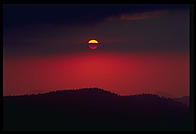
For the vast majority of digital imaging purposes, having a Kodak PhotoCD made is the best convenience/quality/price choice. However, if you really want to buy a scanner yourself and don't want to spend $100,000 on a Kodak PIW, you do have some options.
Drum scanners, which use photomultiplier tubes, capture the most information from a slide, particularly in the shadow. Drum scanners also incorporate hardware unsharp masking. Drums scanners finally are usually parked next to skilled operators at service bureaus who, for $75 and up, will make you a scan that requires little tweaking in PhotoShop.
If you want to make super high-res FlashPix in the privacy of your own home, spend $25,000 on a Howtek HiResolve 8000, which was introduced in the fall 1998. The Howtek will give you the 8000 dpi resolution that you crave from 8 x 10 inch transparencies! Make sure that you also get a writable DVD drive handy to store the resultant 15 GB files!
If you need to do a few 35mm slides or negs at a time, can't wait 2-7 days for a PhotoCD scan, and don't have the budget for a 100 lb. drum scanner, you might find that settling for a desktop CCD scanner isn't so bad. HP makes a surprisingly good one for $500 (see review below). Nikon and Polaroid produce the traditionally popular desktop scanners. They cost around $2,000. Right now it looks like the clear winner in the cheap desktop market is the Nikon LS-2000 Super Coolspan . This plays two interesting tricks: multiple-pass scanning to reduce shadow noise; comparing the image from multiple angles to figure out where the dust and scratches are, then eliminating them automatically. The image quality from the latest and greatest Nikon is probably better than what you get from PhotoCD, but you have to deal with the host of calibration, indexing, and archiving issues that are raised in the image library chapter of my book.
Look at http://www.cix.co.uk/~tsphoto/tech/filmscan/menu for a well-done comparison of desktop scanners.
The most painless way to drive all of these (except the HP) is from a PowerMac running Adobe PhotoShop. The bits go direct from SCSI into PhotoShop and then you can do whatever you need to from there. If you decide to do this with Windows NT, make sure that you budget some time to think about color management and calibration.
Once you get those images in digital form, you'll probably want to either